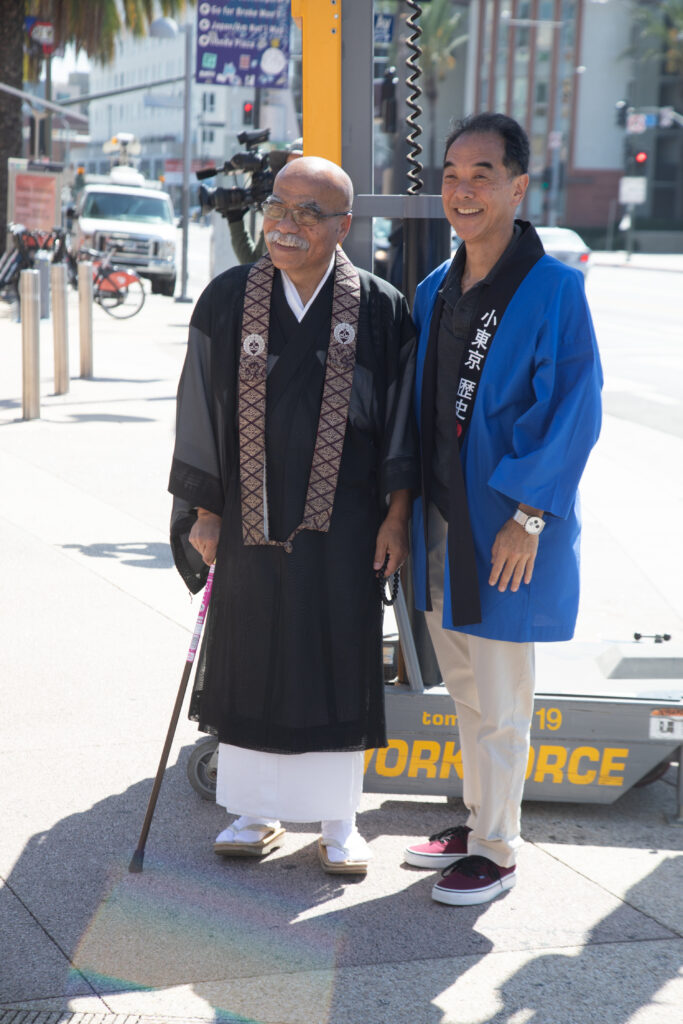On September 12, 2023, the Japanese American National Museum (JANM), Little Tokyo Historical Society (LTHS), and other Little Tokyo partners celebrated the upcoming 100th anniversary of JANM’s Historic Building with a new plaque and street signs marking the building’s significance and its City of Los Angeles Historic Cultural Monument designation.
JANM’s Director of Collections Management and Access and Curator, Kristen Hayashi, welcomed the group and introduced Michael Okamura, president of the Little Tokyo Historical Society, who spoke about the LTHS’s efforts to raise the visibility of historic sites throughout Little Tokyo, including the Koyasan Buddhist Temple, the Kame Restaurant, the Finale Club, Sei Fujii and J. Marion Wright Memorial Lantern, Toyo Miyatake Way, Reverend Howard Toriumi Plaza, and the Aoyama Tree.


“You could tell that throughout Little Tokyo these are significant. We honor these legacy people who were before us and it’s very important. When you walk throughout Little Tokyo please take a moment and absorb all these people and the naming sites,” said Okamura.
Rev. William Briones of Nishi Hongwanji Buddhist Temple then spoke about how the site played an important role in the spiritual and social life of the community.
“It was a place of spiritual refuge, community, a playground for the children, a place to grieve for their loved ones, and to find joy in the joining of two people. And who could forget the iconic picture that Archie Miyatake took? The backdrop of one of the assembly points from which local Issei and Nisei were sent to the camp. Today we are truly honored for this recognition and even though a lot of people don’t know the history of this, there are so many fond and wonderful memories of this temple. Thank you for this recognition,” said Briones. Afterward, both of them unveiled the new signs on 1st Street that now mark the historic site.


The Historic Building was designed by local architect Edgar Cline and built in 1925 as the Nishi Hongwanji Buddhist temple. In 1985, the newly incorporated JANM signed a fifty-year lease with the City of Los Angeles to renovate the temple and convert it into a museum. The renovation was conceived by a consortium of eight Japanese American architects: Marcia Chiono, David Kikuchi, Shigeru Masumoto, Yoshio Nishimoto, Frank Sata, Takashi Shida, George Shinmo, and Robert Uyeda. In 1986 it was designated as City of Los Angeles Historic Cultural Monument 313. In 1992 JANM opened its doors to the public with 23,800 square feet of space for exhibitions, collections, and public programs.
“JANM’s Historic Building is our oldest and largest artifact on our campus. It is hallowed ground, a site of conscience, and a gathering place for civic engagement and social justice. The plaque and street signs not only commemorate the Historic Building’s history in the Japanese American community but also expands the public’s understanding of its significance to the history of Los Angeles and the US. Commemorating the building’s history ensures that past injustices will never be repeated and that diverse voices will be heard now and into the future,” said Ann Burroughs, President and CEO of JANM.



Principal City Planner and Manager for the City of Los Angeles Office of Historic Resources, Ken Bernstein, praised the new plaque and street signs for raising the visibility of the historic site in Little Tokyo.
“Our historic buildings anchor us in an ever changing city. They really provide a meaningful connection to our collective memory—that bridge between past, present, and future. Thanks to you, the historic designation and enhanced visibility through the street sign and the plaque will continue to allow the Little Tokyo community to connect to its rich heritage and really use that rich heritage as a way of continuing to promote the vitality of the Little Tokyo community.”
Actor, activist, JANM Trustee, and Board Chair Emeritus, George Takei, joined Burroughs and Bernstein to unveil the bronze plaque, now installed at the building’s historic entrance.

Hayashi closed the ceremony by noting the significance of the ceremony and the power of place that JANM’s Historic Building has on its own and in relation to JANM’s Pavilion.
“These places matter to us and our community and we want people to know about its significance; that’s why we have this ceremony today. We could’ve just mounted the plaque but instead we really wanted people to know that it’s here. Several people have pointed out that there are several generations of people here today to witness this moment and it’s so fitting because as you turn around and you look towards JANM’s Pavilion, the architects of the Pavilion really wanted us to reflect on our past. Our past is what guides our present and future. It’s symbolic of who’s represented here. We have several generations here to carry on the legacy of those who have come before us in Little Tokyo.”
A special surprise performance by the children of Nishi Daycare charmed the audience of fifty who gathered in the plaza for the celebration.





